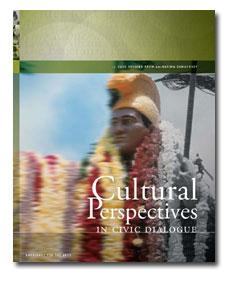
Author: Korza, Pam and Shaffer Bacon, Barbara
Publication Year: 2005
Media Type: Book
Summary:
Cultural Perspectives in Civic Dialogue shares the efforts of cultural organizers who are skilled in working deeply within and across cultures to understand important cultural considerations in arts-based civic dialogue work. Their endeavors illuminate how cultural norms mediate public space and participation, as well as how the choices regarding art forms and dialogue approaches can support or discourage civic participation of various cultural groups. In the King Kamehameha I Statue Conservation Project, rural Hawai’ian residents deliberated how best to conserve a statue of King Kamehameha I and, in the process, deepened understanding of the links between cultural identity, heritage preservation, and current issues of land and economic development. The Center for Cultural Exchange’s African in Maine program supported Sudanese, Congolese, and Somali immigrant and refugee communities in their own cultural programming interests to reveal the diversity and conflicts within and across divided African communities, as well as between Africans and the wider community of “Mainers.” The Esperanza Peace and Justice Center’s ongoing Arte es Vida program addresses issues of cultural equity and democracy related to San Antonio’s Chicano and Mexicano communities. It acts on the idea of cultural grounding - the concept that, in the context of a culturally dominant society, a strong sense of selfhood and identity rooted in cultural practice is necessary to empower marginalized communities toward active participation in public dialogue.
Abstract:
Cultural Perspectives in Civic Dialogue shares the efforts of cultural organizers who are skilled in working deeply within and across cultures to understand important cultural considerations in arts-based civic dialogue work. Their endeavors illuminate how cultural norms mediate public space and participation, as well as how the choices regarding art forms and dialogue approaches can support or discourage civic participation of various cultural groups. In the King Kamehameha I Statue Conservation Project, rural Hawai’ian residents deliberated how best to conserve a statue of King Kamehameha I and, in the process, deepened understanding of the links between cultural identity, heritage preservation, and current issues of land and economic development. The Center for Cultural Exchange’s African in Maine program supported Sudanese, Congolese, and Somali immigrant and refugee communities in their own cultural programming interests to reveal the diversity and conflicts within and across divided African communities, as well as between Africans and the wider community of “Mainers.” The Esperanza Peace and Justice Center’s ongoing Arte es Vida program addresses issues of cultural equity and democracy related to San Antonio’s Chicano and Mexicano communities. It acts on the idea of cultural grounding - the concept that, in the context of a culturally dominant society, a strong sense of selfhood and identity rooted in cultural practice is necessary to empower marginalized communities toward active participation in public dialogue.
Arts & Intersections: Art
Categories: Public Art, Cultural Diversity, Civic Dialogue and Social Change, Access and Equity
ADDITIONAL BIBLIOGRAPHICAL INFORMATION
Series Title:
Edition: Art and Civic Engagement Series
URL:
SBN/ISSN:
Pages: 106
Resources:
PUBLISHER INFORMATION
Name: Americans for the Arts
Website URL: https://www.americansforthearts.org